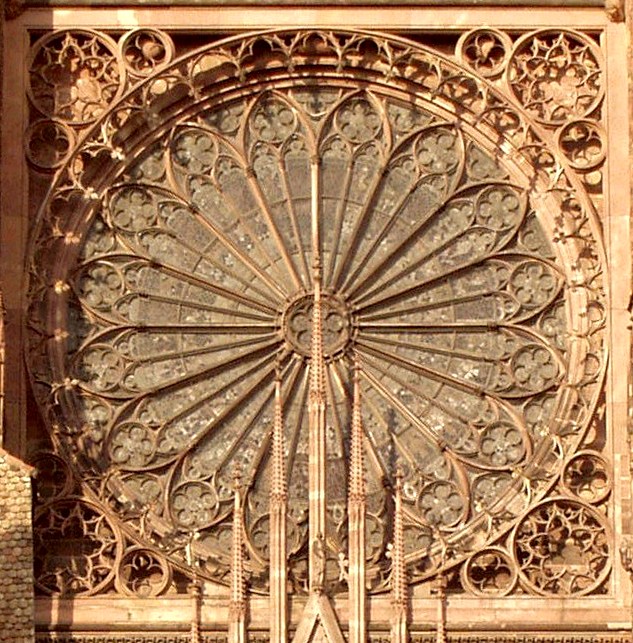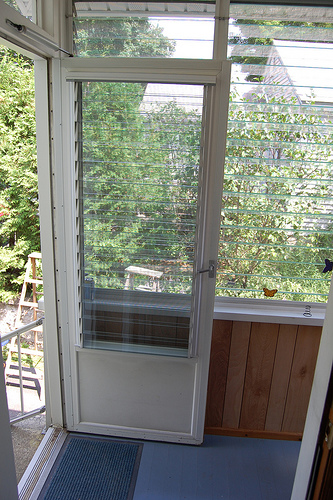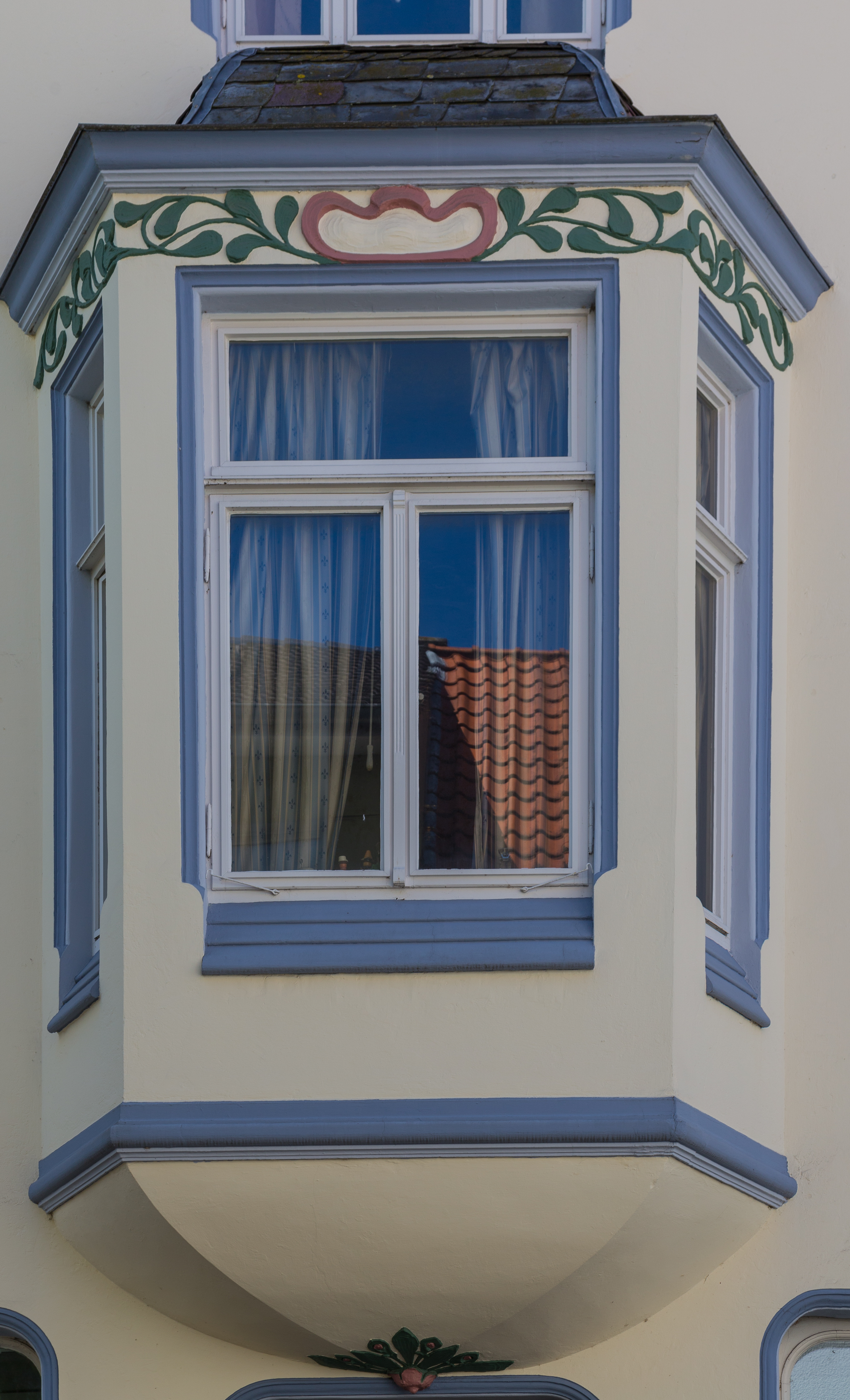|
Window
A window is an opening in a wall, door, roof, or vehicle that allows the exchange of light and may also allow the passage of sound and sometimes air. Modern windows are usually glazed or covered in some other transparent or translucent material, a sash set in a frame in the opening; the sash and frame are also referred to as a window. Many glazed windows may be opened, to allow ventilation, or closed to exclude inclement weather. Windows may have a latch or similar mechanism to lock the window shut or to hold it open by various amounts. Types include the eyebrow window, fixed windows, hexagonal windows, single-hung, and double-hung sash windows, horizontal sliding sash windows, casement windows, awning windows, hopper windows, tilt, and slide windows (often door-sized), tilt and turn windows, transom windows, sidelight windows, jalousie or louvered windows, clerestory windows, lancet windows, skylights, roof windows, roof lanterns, bay windows, oriel windows, ... [...More Info...] [...Related Items...] OR: [Wikipedia] [Google] [Baidu] |
Rose Window
Rose window is often used as a generic term applied to a circular window, but is especially used for those found in Gothic cathedrals and churches. The windows are divided into segments by stone mullions and tracery. The term ''rose window'' was not used before the 17th century and comes from the English flower name rose. The name "wheel window" is often applied to a window divided by simple spokes radiating from a central boss or opening, while the term "rose window" is reserved for those windows, sometimes of a highly complex design, which can be seen to bear similarity to a multi-petalled rose. Rose windows are also called "Catherine windows" after Saint Catherine of Alexandria, who was sentenced to be executed on a spiked breaking wheel. A circular window without tracery such as are found in many Italian churches, is referred to as an ocular window or Oculus (architecture), oculus. Rose windows are particularly characteristic of Gothic architecture and may be seen in all th ... [...More Info...] [...Related Items...] OR: [Wikipedia] [Google] [Baidu] |
Stained Glass
Stained glass refers to coloured glass as a material or art and architectural works created from it. Although it is traditionally made in flat panels and used as windows, the creations of modern stained glass artists also include three-dimensional structures and sculpture. Modern vernacular usage has often extended the term "stained glass" to include domestic leadlight, lead light and ''objet d'art, objets d'art'' created from glasswork, for example in the famous lamps of Louis Comfort Tiffany. As a material ''stained glass'' is glass that has been coloured by adding Salt (chemistry), metallic salts during its manufacture. It may then be further decorated in various ways. The coloured glass may be crafted into a stained-glass window, say, in which small pieces of glass are arranged to form patterns or pictures, held together (traditionally) by strips of lead, called cames or calms, and supported by a rigid frame. Painted details and yellow-coloured Silver staining, silver stain ... [...More Info...] [...Related Items...] OR: [Wikipedia] [Google] [Baidu] |
Sash Window
A sash window or hung sash window is made of one or more movable panels, or "sashes". The individual sashes are traditionally paned windows, but can now contain an individual sheet (or sheets, in the case of double glazing) of glass. History The oldest surviving examples of sash windows were installed in England in the 1670s, for example at Palace House, and Ham House.Louw, HJ, ''Architectural History'', Vol. 26, 1983 (1983), pp. 49–72, 144–15JSTOR The invention of the sash window is sometimes credited, without conclusive evidence, to Robert Hooke. Others see the sash window as a Dutch invention. H.J. Louw believed that the sash window was developed in England, but concluded that it was impossible to determine the exact inventor. The sash window is often found in Georgian and Victorian houses, and the classic arrangement has three panes across by two up on each of two sash, giving a ''six over six'' panel window, although this is by no means a fixed rule. Innumerable ... [...More Info...] [...Related Items...] OR: [Wikipedia] [Google] [Baidu] |
Jalousie
A jalousie window (, ), louvred window (Australia, New Zealand, Pacific Islands, Southeast Asia, United Kingdom), jalousie, or jalosy is a window composed of parallel glass, acrylic, or wooden louver, louvres set in a frame. The louvres are joined onto a track so that they may be tilted open and shut in unison to control airflow, usually by turning a crank. Etymology ''Jalousie'' is the French word for "jealousy". It originated in 18th century France from the Italian word ''geloso'', which means "jealous" or "screen", as in to screen something from view. Because of their slatted louvres, jalousie windows protect the interior of the house from jealous, peering eyes (when not made of a transparent material like glass). Design Joseph W. Walker of Malden, Massachusetts, applied for a US patent for a basic louvered window in 1900. He was issued patent no. 687705 on November 26, 1901. A popular hand-cranked glass, aluminum and screen window combination was later designed by Ame ... [...More Info...] [...Related Items...] OR: [Wikipedia] [Google] [Baidu] |
Witch Window
In American vernacular architecture, a witch window (also known as a Vermont window, among other names) is a window (usually a double-hung sash window, occasionally a single-sided casement window) placed in the gable-end wall of a houseGeorge Nash, '' Renovating Old Houses: Bringing New Life to Vintage Homes''. The Taunton Press, Newtown, Connecticut, 2003, p. 8. and rotated approximately 1/8 of a turn (45 degrees) from the vertical, leaving it diagonal, with its long edge parallel to the roof slope.Howard Frank Mosher, A Stranger in the Kingdom'', Houghton Mifflin Co., New York, 1989 (republished 2002), p. 46. This technique allows a builder to fit a full-sized window into the long, narrow wall space between two adjacent roof lines, where a window would not otherwise fit. Witch windows are found almost exclusively in or near the U.S. state of Vermont, generally in the central and northern parts of the state.Justin Falango,Architectural Details: New England", Dover, Kohl & Partne ... [...More Info...] [...Related Items...] OR: [Wikipedia] [Google] [Baidu] |
Bay Window
A bay window is a window space projecting outward from the main walls of a building and forming a bay in a room. A bow window is a form of bay with a curve rather than angular facets; an oriel window is a bay window that does not touch the ground. A window may be all three: projecting outward from the main fascia of a wall, curved in shape, and not reaching the ground. A bay window may be supported from the ground by a foundation, or in space by corbels, brackets, or cantilever. A typical bay window consists of a central windowpane, called a fixed sash, flanked by two or more smaller windows, known as casement or double-hung windows. The arrangement creates a panoramic view of the outside, allows more natural light to enter the room, and provides additional space within the room. Bay windows are often designed to extend beyond the exterior wall, either adding to floor space, often filled with a table, desk, or seating area, or turned into a window seat (often with storage o ... [...More Info...] [...Related Items...] OR: [Wikipedia] [Google] [Baidu] |
Casement Window
A casement window is a window that is attached to its frame by one or more hinges at the side. They are used singly or in pairs within a common frame, in which case they are hinged on the outside. Casement windows are often held open using a casement stay. Windows hinged at the top are referred to as awning windows, and ones hinged at the bottom are called hoppers. Overview Throughout Britain and Ireland, casement windows were common before the sash window was introduced. They were usually metal with leaded glass, which refers to glass panes held in place with strips of lead called cames (leaded glass should not be confused with lead glass, which refers to the manufacture of the glass itself). These casement windows usually were hinged on the side, and opened inward. By the start of the Victorian era, opening casements and frames were constructed from timber in their entirety. The windows were covered by functional exterior shutters, which opened outward. Variants of cas ... [...More Info...] [...Related Items...] OR: [Wikipedia] [Google] [Baidu] |
Glazing (window)
Glazing, which derives from the Middle English for 'glass', is a part of a wall or window, made of glass. Glazing also describes the work done by a professional "glazier". Glazing is also less commonly used to describe the insertion of ophthalmic lenses into an eyeglass frame. Common types of glazing that are used in architectural applications include clear and tinted float glass, tempered glass, and laminated glass as well as a variety of coated glasses, all of which can be glazed singly or as Insulated glazing, double, or even triple, glazing units. Ordinary clear glass has a slight green tinge, but special colorless glasses are offered by several manufacturers. Glazing can be mounted on the surface of a window Sash window, sash or door Frame and panel, stile, usually made of wood, aluminium or Polyvinyl chloride, PVC. The glass is fixed into a rabbet, rabbet (rebate) in the frame in a number of ways including triangular glazing points, putty, etc. Toughened and laminated glas ... [...More Info...] [...Related Items...] OR: [Wikipedia] [Google] [Baidu] |
Oriel Window
An oriel window is a form of bay window which protrudes from the main wall of a building but does not reach to the ground. Supported by corbels, bracket (architecture), brackets, or similar cantilevers, an oriel window generally projects from an upper floor, but is also sometimes used on the ground floor. Etymology According to the ''Oxford English Dictionary'', the term ''oriel'' is derived from Anglo-Norman language, Anglo-Norman ' and Late Latin ', both meaning "gallery" or "porch", perhaps from Classical Latin ' ("curtain"). History Oriel windows became popular in the 15th century. They allowed more sunlight into a room compared to conventional flat windows, and were therefore popular in northern countries such as England. They also could increase the usable space in a house without changing the footprint of the building. Oriel windows are seen in Islamic architecture, Arab architecture in the form of mashrabiya and in Turkish are known as ''şahnişin'' or ''cumba''. ... [...More Info...] [...Related Items...] OR: [Wikipedia] [Google] [Baidu] |
Hexagonal Window
A hexagonal window (also Melnikov's or honeycomb window) is a hexagon-shaped window, resembling a bee cell or crystal lattice of graphite. The window can be vertically or horizontally oriented, openable or fixed. It can also be regular or elongately-shaped and can have a separator ( mullion). Typically, the cellular window is used for an attic or as a decorative feature, but it can also be a major architectural element to provide the natural lighting inside buildings. The hexagonal window is relatively rare and associated with such architectural styles as constructivism, functionalism and, occasionally, cubism. History Attic hexagonal windows were occasionally used in the Northern European manor architecture of the 19th century. The concept became popular thanks to the Russian constructivist architect Konstantin Melnikov, whose own famous house had 124 hexagonal windows, which were the main source of light as ceiling lights were not provided in many rooms. Cellular windows are ... [...More Info...] [...Related Items...] OR: [Wikipedia] [Google] [Baidu] |
Door
A door is a hinged or otherwise movable barrier that allows ingress (entry) into and egress (exit) from an enclosure. The created opening in the wall is a ''doorway'' or ''portal''. A door's essential and primary purpose is to provide security by controlling access to the doorway (portal). Conventionally, it is a panel that fits into the doorway of a building, room, or vehicle. Doors are generally made of a material suited to the door's task. They are commonly attached by hinges, but can move by other means, such as slides or counterbalancing. The door may be able to move in various ways (at angles away from the doorway/portal, by sliding on a plane parallel to the frame, by folding in angles on a parallel plane, or by spinning along an axis at the center of the frame) to allow or prevent ingress or egress. In most cases, a door's interior matches its exterior side. But in other cases (e.g., a vehicle door) the two sides are radically different. Many doors incorporate lock ... [...More Info...] [...Related Items...] OR: [Wikipedia] [Google] [Baidu] |








